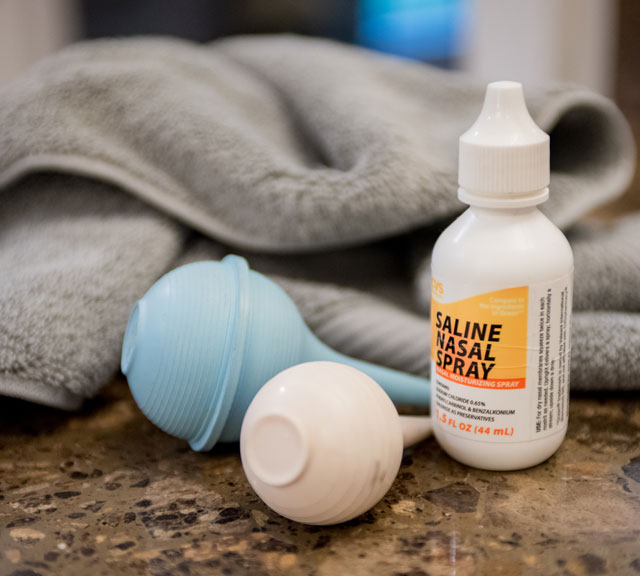Stuffy Nose Relief — Naturally

Answer a few questions and we'll provide you with a list of primary care providers that best fit your needs.
If nasal allergies are causing you the misery of a runny or stuffy nose, excess mucus or irritated sinuses, a saline nasal rinse could offer welcome relief. Nasal rinses have been around for hundreds of years as a way of cleansing and clearing the nose and sinuses.
 Rinses help by:
Rinses help by:
- Clearing the nose of mucus
- Reducing inflammation
- Removing small particles, bacteria and viruses
- Preventing colds and chronic sinus infections
You can use the rinse along with your usual allergy medications, and you may find afterwards that they actually work better.
Before starting, know and follow these guidelines:
- Talk with your doctor to ensure that it’s a good option for you.
- Use only sterile water with your rinse. Rare cases of people using rinses with non-sterilized water have resulted in brain infection and even death from a parasitic amoeba that reaches brain tissue through the nasal membranes.
- Rinse only occasionally, since routine use may strip the protective membranes lining the inside of your nose and sinuses.
- Do not use a nasal rinse with infants.
- Do not use a rinse if your nasal passages are severely blocked.
Creating a Sterile Solution
You can buy nasal rinse at a local drugstore or create your own saline rinse with this recipe from the American Academy of Allergy, Asthma & Immunology:
Saline Rinse
- 3 heaping tsp. salt used for pickling or canning. The kosher salt should have no iodide, anti-caking agents or preservatives. Any of these can irritate your nasal passages
- 1 rounded tsp. baking soda
- 1 cup (8 oz.) lukewarm sterile or boiled water
Use a clean, airtight container to mix salt and baking soda and store. Add 1 teaspoon of the mixture to 8 ounces of lukewarm water.
If the solution causes burning or stinging in your nose, use less of the salt/baking soda mixture. If you are preparing solution for a child, use 4 ounces of water with ½ teaspoon of the dry mix.
How to Irrigate Nasal Passages
To apply the rinse to your nasal passages, use a soft rubber bulb syringe, a nasal bulb for infants, or an applicator provided with a store-bought rinse.
- Draw the solution into the bulb. Tilt your head downward over the sink or in the shower.
- Turn your head to the right so your right nostril is on top.
- Gently squeeze about 4 ounces of the liquid into your right nostril. Breathe normally through your mouth, and the solution should come out your left nostril. Rotate your head and repeat the process on the other side. Adjust your position to prevent liquid from going down the back of your throat or into your ears.
- Gently blow your nose to help keep solution from going into your ears.
Neti Pots
A neti pot, which resembles a small teapot, offers another way to administer a saline rinse to your nasal passages. Use the recipe above or try a saline solution with1 ½ teaspoons of pure sodium chloride (kosher salt as described above) and a liter of sterile, lukewarm water (about 34 ounces).
Nasal irrigation can provide significant relief for a wide range of allergy symptoms.
Pour the solution into the neti pot and place the spout into your top nostril, as described above. Repeat on the other side.
Supporters of the technique claim that neti pots and other nasal rinses offer significant relief from nasal congestion and irritation. Some people say the process reduces headaches resulting from sinus congestion. It may decrease the amount of medicine you need to fight sinus infections or control allergy symptoms.
Numerous clinical trials have been conducted, and most agree that nasal irrigation is safe and well tolerated, as long as the solution and delivery devices are sterile.
For many, nasal irrigation can provide significant relief for a wide range of allergy symptoms.
Answer a few questions and we'll provide you with a list of primary care providers that best fit your needs.
Source: Healthline; American Academy of Allergy, Asthma and Immunology; American Rhinologic Society




